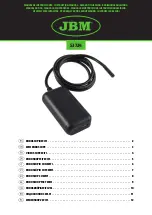
operation
file: n:\article\cos14310m5-v1_07hpc-en\20130207_cos14310m5-v1.07hpc-en_h-p-cosmos_treadmill_manual.doc
© 2013 h/p/cosmos sports & medical gmbh author: fh [email protected] created 07.02.2013 printed 04.03.2013 page: 38 of 197
5.6
Application: Ergometry / Cardiology ECG treadmill stress test
This test is indicated for patients who are suspected of having a cardiovascular disease (diagnostics and therapy). The
benefit will be that disease of the cardiovascular system may be detected and treated early and in a controlled
surrounding. The benefit of this application can only be achieved in combination with an external ECG device and
diagnosis and therapy have to be performed by a medical doctor.
If controlling the treadmill via ECG, pay special attention to the ECG manufacturer’s manual!
The summary of clinical data and the risk management of h/p/cosmos do NOT cover any measured
parameters and/or vital functions which are measured and/or detected by host devices (e.g. ECG,
ergospirometry devices, EMG, etc.) connected to the treadmill.
In order to check the reaction of the cardiovascular system to physical load, the patient is confronted with steadily
increasing load on the treadmill. h/p/cosmos para control
®
or h/p/cosmos para graphics
®
offers protocols that provide an
increasing load to the patient either by
N
increasing velocity at constant elevation,
N
increasing elevation at constant velocity or
N
a combination of both.
The protocols can be selected in the “test-mode” (see chapter 5.9.5 “Test mode”). You can also create a user-defined
profile, either using the “graded test” or the “freely definable user profiles”.
Also see guidelines of German or American Heart Associations:
Deutsche Gesellschaft für Kardiologie – Herz- und Kreislaufforschung e. V:
http://leitlinien.dgk.org
American Heart Association.
http://www.heart.org
and
http://circ.ahajournals.org/content/96/1/345.full
5.7
Application: Gait analysis and rehabilitation with neurologic patients
Gait analysis, gait correction and rehabilitation on the treadmill is indicated for patients suffering from pathologic gait
pattern, e.g. after stroke.
Neurologic gait therapy could be performed using any h/p/cosmos treadmill, but with different comfort. h/p/cosmos
recommends the use of h/p/cosmos locomotion
®
with unweighting system “airwalk se” to perform the gait training in a
controlled surrounding on the treadmill. The unweighting system prevents falling, and the duration of therapy can be
increased. Arm supports and expander cables with leg cuffs (robowalk
®
) can be also used for support. The still adaptive
neuronal system is stimulated via motion support in manual locomotion therapy, and an improvement of the motion
pattern for many patients can be reached under safe circumstances. Manual locomotion therapy is the basis of
physiologic treatment of neurologic patients. The patient walks on the treadmill while the therapist is sitting next to
him/her, supporting and correcting the patient’s motion. Only very low speed is needed; it makes sense to control the
treadmill in the “manual mode” at a speed of 0.1 to 4.0 km/h.
5.8
Application: Gait analysis and rehabilitation with force measurement plates
The h/p/cosmos Kistler Gaitway
®
is an h/p/cosmos treadmill based on the model mercury
®
med, equipped with two
Kistler force measurement plates. It is the only h/p/cosmos treadmill with these features. The system measures the
vertical ground reaction forces and thereby collects a large amount of force and time-based gait parameters. The total
force path can be displayed with the Kistler Gaitway
®
software. Experts know how to interpret the force path and use it
as basis for therapy.
















































